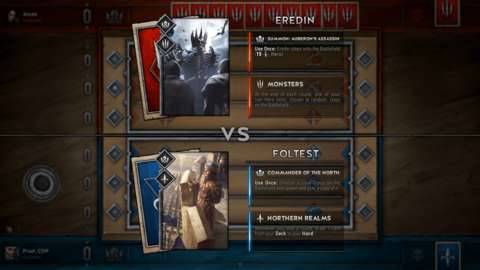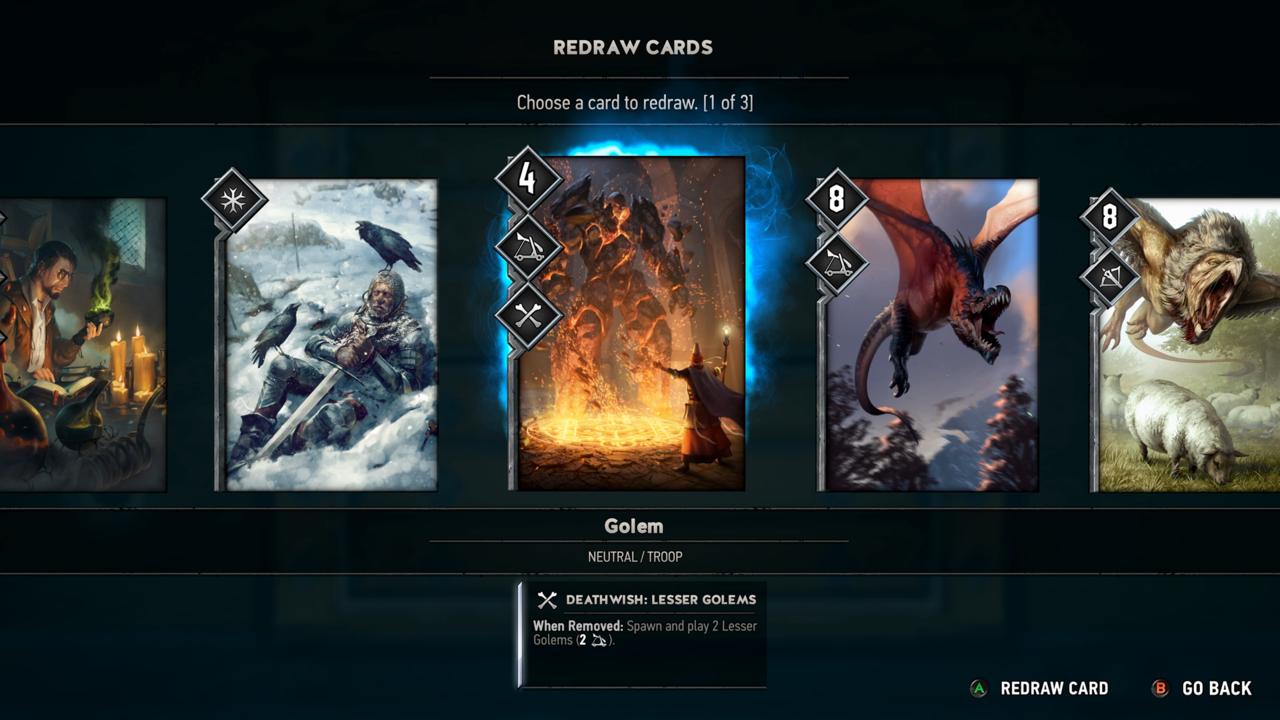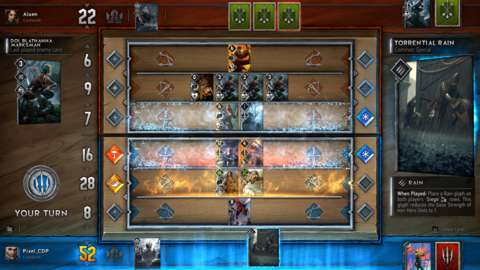If you've played The Witcher 3: Wild Hunt, you've run into the in-game collectible card game Gwent. There's a good chance you also spent some time ignoring the rest of the game and only playing Gwent. The card game was so popular in The Witcher 3 that developer CD Projekt Red is making a standalone version for consoles and PC. However, even though it's a CCG, Gwent has more in common with the popular role-playing game than you'd expect.
At E3 2016 I was able to go hands on with a multiplayer demo of the game and then sit down with its narrative designer, Mateusz Tomaszkiewicz. I came away encouraged by its depth and complexity, and I found out that it's very much still a CD Projekt Red game and will be very familiar to fans of The Witcher 3.
When I began playing, I quickly realized that the standalone Gwent is not just a port of the in-game version. Whereas The Witcher 3's Gwent was functional but utilitarian, essentially just a screen of a wooden card table with some minor animations, the standalone Gwent has stylish and robust design with many artistic flourishes. When battling an opponent, it's still the same Gwent that you played in The Witcher 3, but the wrapping around it--the setup, playing cards, using magic--all looks far better.

Cards have new designs, with detailed backgrounds and character art. Leaders have a bunch more dialogue, calling out throughout a battle. Some cards played on the board will talk as well, giving this game a dynamic, living feel.
Tomaszkiewicz told me that CDPR wanted it to feel this way--these battles aren't meant to be just card games between friendly rivals in a pub. The Gwent matches in the standalone release are supposed to evoke the sense of pitched combat between armies. As a result, magic and abilities are clearly messaged in the game, and attacks like Scorch feel impactful. It even has similar sound and visual design to the Scorch ability in The Witcher 3, a nice way for the game to feel more grounded.
However, this game is still Gwent. CDPR has obviously made some balance and card tweaks, but the rules are still the same, and gameplay still unfolds identically.
But there are several card games doing similar things on the market this year. Hearthstone is a behemoth; The Elder Scrolls is getting its own fantasy tie-in CCG. It's not exactly a new genre. So I asked Tomaszkiewicz what made Gwent unique. "It'll stand out in terms of single player because we're putting a lot of effort into it to make it the best it can be," he replied. It's a very straightforward answer for what is perhaps the most surprising element of the standalone Gwent: a robust, unique, and very Witcher-like story.

It's why Tomaszkiewicz is on the project in the first place. He was the lead quest designer on The Witcher 3 and worked on narrative in The Witcher 2, as well. He works on Gwent alongside Karolina Stachyra, who helped design the well-known Bloody Baron questline in The Witcher 3. CDPR is serious about single-player in Gwent, and although I didn't get to play it myself, the demo I saw makes me excited to see more.
It's a full story--well, really, multiple stories. Each faction in the game (Scoia'tael, Skellige, Northern Kingdoms, and Monsters) will have its own fully voiced, 10+ hour campaign, with branching storylines and player choice. "It's not so simple to come up with a story for you playing as monsters," Tomaszkiewicz said. "But we have some ideas about it and I think it'll be pretty cool."
The game's story is presented in cutscenes that are somewhat similar to the storybook-like cel-shaded characters in games like The Banner Saga. At the moment, the characters in these scenes only have minor animation, but CDPR is looking to add more. Each of these scenes have dialogue options, and you'll have to make difficult choices that can impact the larger story.
But it doesn't end there. There is also a map you can walk around in. From a top-down perspective, you control a character moving through the map that CDPR claims is an open world. "There are events you can find, there are treasures you can find, some things might change in the map based on your decisions. There are secrets to find. As you progress through the map, it will evolve based on your choices. Tomaszkiewicz explains that, in the world, "There are events you can find, there are treasures you can find, some things might change in the map based on your decisions. There are secrets to find."

It's surprising that this mode is showing up in a collectible card game, but CDPR simply doesn't make games without narrative. Tomaszkiewicz told me, "We always did hard choices, morally gray choices, with impactful consequences. And this time around we want to do the same thing."
This is where CDPR's efforts to position the game as featuring pitched battles between armies, rather than just card matches, becomes even more important. Tomaszkiewicz and the other designers are using this to try to make Gwent work within this wider, meta-story. "This time around you are building an army," he explained. The cards you find in the world will essentially be "soldiers" in your brigade. He continued: "It'll be a story told from the perspective of leaders, and this is a big challenge because we have to come up with a new way to introduce choices and a new way to introduce exploration, and how you solve sidequests and side activities."
As I learned about it, standalone Gwent seemed more and more like it's being positioned as a Witcher game itself. You'll pursue multiple objectives at a time, find quests throughout the world, and change the story based on your choices. Elements of Gwent that made it so interesting in The Witcher 3 are coming back, too. You'll still pursue cards throughout the world and find them when completing quests and events.
I didn't see much of the single-player, but the short part I saw and what Tomaszkiewicz told me make it sound unique and exciting within the collectible card game genre. I'm still skeptical about how all of what CDPR is promising for the story will come together, because it's promising a lot. It'll be a pretty substantial effort to tie all of these disparate parts together into a cohesive game, but Gwent has a lot of potential to hit both the narrative of the Witcher series and the engaging, competitive nature of collective card games.
There will be a closed beta for the game on Xbox One and PC in September, and you can register for it now. The game will eventually launch on Xbox One, PS4, and PC, but there's no word yet on the release date.

